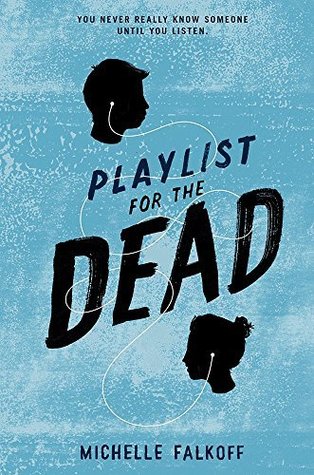
 When someone hands me a book with a title like “Playlist For The Dead” a cacophony of thoughts run through my head.
When someone hands me a book with a title like “Playlist For The Dead” a cacophony of thoughts run through my head.
#1. Can I read this book in public? Not because I’m embarrassed about said book (as a general rule I don’t give a flying rats posterior about WHAT people see me reading, at least I’m reading…not playing Candy Crush) but I refuse to ugly cry in a Starbucks.
#2. Can I handle the inevitability of sadness? (Am I feeling emotionally stable today?)
And #3. Will I be able to write a review about the book without sounding like a self-help pamphlet? (The jury is still out on that one, just FYI.)
In short: books like “Playlist For The Dead” take commitment. Something I often struggle with.
That’s not to say that books like this aren’t “good” or as is the case with Playlist…completely unexpected, BUT it IS about suicide, and the repercussion of such a selfish act can be a traumatic thing to read about. So, be prepared for that.
But first, let me back up the train a little bit and tell you what the book is all about.
Here’s what Sam knows: There was a party. There was a fight. The next morning, his best friend, Hayden, was dead. And all he left Sam was a playlist of songs, and a suicide note: For Sam—listen and you’ll understand.
As he listens to song after song, Sam tries to face up to what happened the night Hayden killed himself. But it’s only by taking out his earbuds and opening his eyes to the people around him that he will finally be able to piece together his best friend’s story. And maybe have a chance to change his own.
Here’s the thing, I don’t want to spend the next two hours writing and editing a review that dwells solely on the negative plot aspects of this book (ie: the emotional backlash of teenage suicide) so instead I’m going to focus on what my inner geek found utterly compelling. Michelle Falkoff’s attention to (cultish) pop culture. From Donnie Darko to Buffy the Vampire Slayer, Joss Whedon and Captain Mal to Star Wars and Mage Warfare, “Playlist” was a magical trot through a perfectly structured geekdom library. I found this writing quirk engaging in a way that should be embarrassing on some level (full disclosure: I highlighted every reference) but I’m not. Instead, I found myself impressed by the way these references painted pictures between the characters.
For example: Chapter 4 is titled “Invisible” (which is a song by Skylar Gray.) If you take the time to Youtube/Spotify/Google the song, you will discover that the lyrics are a reflection of what Hayden was feeling before he took his own life.
Even when I’m walking on a wire
Even when I set myself on fire
Why do I always feel invisible, invisible
Everyday I try to look my best
Even though inside I’m such a mess
Why do I always feel invisible, invisible
Quite frankly, it’s a genius way to character build and captivate a reader without having to spell everything out on the page. Especially for a character that is a very big part of the story without actually being IN the story. Or, to be more accurate, to build the character that is a catalyst for MULTIPLE character’s journey to self discovery. (Oh man, here comes the self-help mumbo-jumbo.) Though the book is ABOUT Hayden, the plot itself (aside for the question of “Why?”) has very little to do with him. Instead, it’s about his BFF Sam. How he handles loss (sleep deprivation) and guilt (hallucinations.) It’s about Astrid (a once poster perfect cheerleader turned emo chick) who struggles with anger. It’s about Eric (the hipster boy who lives on a farm and wear clickity shoes) and the bully trifecta (who fail to realize the impact their actions have on impressionable peers.) It’s about the AFTER, the “What now?” The gut wrenching probability that one of them might hold the answers to Hayden’s choice.
It is…the perfect combination of nerd and heart.
All that said, it’s not a very FAST moving book, and the mystery? Sorry, but it’s not all that mysterious. (Not that I expected it to be anyways.) What I did expect? To cry. Much like I did with Stephen Chbosky’s “The Perks of Being a Wallflower” and Tim Tharp’s “The Spectacular Now” (Both of which make appearances in the synopsis for this novel.) Surprisingly…I didn’t. (Not that I’m at all complaining about a lack of salt and snot running down my face.) Though sad, it’s not a blabber fest type of book. Think of it more as an “internal reflection” spread out over 279 pages.
With a narrative that resides in the eclectic, I will hazard a guess that this book isn’t for everyone. BUT…it will find a loving home in the hands of YA Contemporary fans, John Green enthusiast, and Jay Asher aficionados. If that is you, run…run like the wind my friend.
Happy Reading my fellow Kindle-ites and remember: “People are going to say a lot of things. And some of it will be helpful, and some of it will be annoying, and lots of it will get on your nerves. But they’re saying it because they found it helpful when they lost someone. They mean well.” – “Playlist For The Dead”
Add it to your Goodreads shelf / Amazon wishlist
| Rating Report | |
|---|---|
| Plot | |
| Characters | |
| Writing | |
| Pacing | |
| Overall: | 3.3 |





